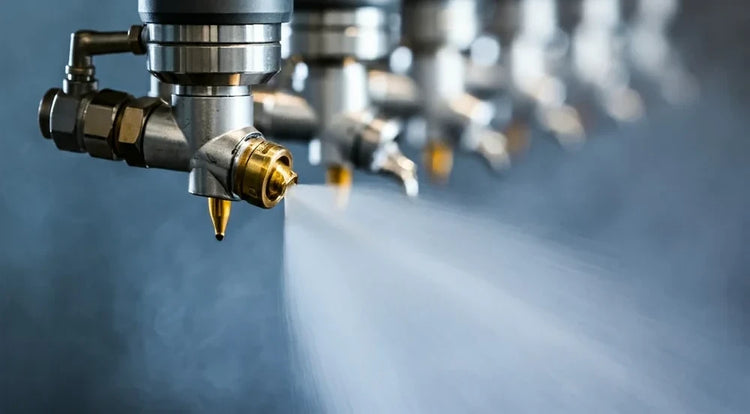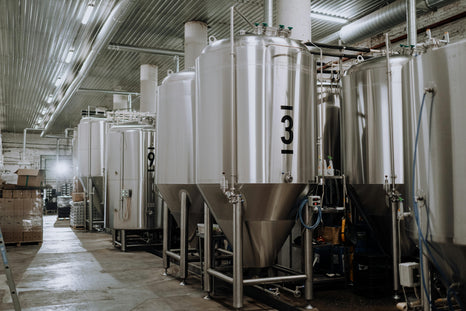So, you're working with metals and need them to be just right? Cooling them down fast is a big deal for how strong and useful they end up being. There are a few ways to do this, but one really common and effective method is called spray quenching. It's basically spraying water or other liquids onto hot metal to cool it down quickly. We're going to break down how this spray quenching stuff works, what you can do to get the best results, and how it stacks up against just letting things cool in the air.
Key Takeaways
- Rapid cooling, often done with spray quenching, changes metal properties, making them harder and stronger.
- Spray quenching is different from other cooling methods because it uses targeted liquid sprays for faster, controlled cooling.
- For aluminum profiles, different spray quenching techniques like water mist or direct water cooling are used depending on the profile's size and desired strength.
- Controlling the temperature of the metal, how fast it moves, and the water pressure are all important for effective spray quenching.
- Spray quenching is generally faster and more effective than air cooling for improving metal strength, though air cooling can sometimes be sufficient if done quickly enough.
Understanding Spray Quenching Fundamentals
When we talk about making metal stronger and more useful, how we cool it down after it's been heated up is a big deal. This process, often called quenching, is super important for getting the properties we want in the final metal product. Spray quenching is one way to do this, and it's pretty common in metalworking.
The Role of Rapid Cooling in Metal Properties
Think about how a blacksmith cools a hot sword in water to make it hard. That's a basic idea of quenching. For metals like aluminum, cooling them down quickly after they've been shaped at high temperatures changes their internal structure. This change can make the metal much stronger, harder, and sometimes more resistant to wear. The speed of this cooling directly affects how the metal's crystals arrange themselves, which in turn dictates its final mechanical strength and other characteristics. Different metals and alloys need different cooling rates to get the best results. For instance, some aluminum alloys need to be cooled very fast to prevent certain undesirable structures from forming, while others might benefit from a slightly slower, more controlled cool.
Distinguishing Spray Quenching from Other Cooling Methods
So, how is spray quenching different from just dunking metal in a tank of water or just letting it sit in the air? Well, spray quenching uses a fine mist or direct streams of liquid, usually water, sprayed directly onto the hot metal surface. This allows for a much more controlled cooling process compared to immersion quenching, where the entire part is submerged. Immersion can sometimes lead to uneven cooling or thermal shock if not managed carefully. Air cooling, on the other hand, is much slower. While air cooling is suitable for some applications, like certain aluminum window frames that need to avoid warping, it doesn't provide the rapid cooling needed for many high-strength alloys. Spray quenching offers a middle ground, providing faster cooling than air but with more control over the cooling rate and uniformity than full immersion.
Key Parameters Influencing Spray Quenching Effectiveness
Getting spray quenching right isn't just about spraying water. Several things need to be just right. The nozzle design is a big one – different nozzles create different spray patterns and droplet sizes, which affect how heat is removed. The pressure of the water is also important; higher pressure can mean a more intense cooling effect. The temperature of the water matters too, as does the distance between the nozzle and the metal. Even the speed at which the metal is moving past the spray can make a difference. Getting these parameters dialed in helps achieve the desired metal properties consistently.
Here's a quick look at some factors:
- Nozzle Type: Affects spray pattern and droplet size.
- Water Pressure: Controls the intensity of the spray.
- Water Temperature: Influences the overall cooling rate.
- Spray Distance: Determines how concentrated the cooling is.
- Metal Speed: Impacts the duration of cooling on any given spot.
Managing these variables allows manufacturers to fine-tune the cooling process for specific alloys and desired outcomes, moving beyond simple cooling to actively shaping the metal's performance.
Spray Quenching Techniques for Aluminum Profiles
When we talk about cooling aluminum profiles, especially the bigger ones, it's a bit like how blacksmiths used to cool metal. You've got to get that temperature down fast to get the properties you want. For aluminum, this means choosing the right spray quenching method.
Optimizing Water Mist Spray for Delicate Profiles
For those intricate, delicate aluminum profiles, a direct blast of water can be too much. It can cause warping or even damage. That's where a fine water mist comes in handy. It provides a gentler, more controlled cooling. The idea is to get a good cooling rate without shocking the metal. This method is great for profiles where maintaining precise dimensions is key. It helps achieve a consistent metallurgical transformation across the surface.
Direct Water Cooling for Large-Caliber Extrusions
Now, for the big, beefy aluminum extrusions, you need something more robust. Direct water cooling is the way to go here. We're talking about a high cooling strength and a rapid drop in temperature. This isn't just about cooling; it's about refining the internal structure of the metal. Think of it as giving the metal a really good heat treatment process. This helps increase the density of the material, which in turn boosts its mechanical strength and makes subsequent treatments more effective. Getting the parameters right is important:
| Parameter | Typical Range |
|---|---|
| Casting Temperature | 710-730℃ |
| Casting Speed | 50-70 mm/min |
| Cooling Water Pressure | 0.1-0.3 MPa |
Achieving T5 and T6 Temper States Through Spray Quenching
The T5 and T6 temper states are common goals in aluminum processing, and spray quenching plays a big role in getting there. The T5 state is typically achieved with air cooling after extrusion, while T6 involves a faster cooling rate, often with water. The speed of cooling directly impacts the final properties. While some argue that fast air cooling can mimic water cooling, direct water quenching generally offers a superior cooling effect, leading to better hardness after aging. The choice between T5 and T6 often depends on the profile's geometry and the need to avoid deformation. For instance, thinner profiles might be better suited for T5 to prevent warping during rapid cooling, whereas thicker ones can handle the more aggressive T6 treatment. This process is a key part of the alloy quenching process and is distinct from induction hardening quenching used for steels, as aluminum alloys have unique responses to rapid cooling.
Controlling the cooling rate is paramount. Too slow, and you don't get the desired temper. Too fast, and you risk thermal shock or unwanted residual stress in steel (though less of a concern in aluminum compared to steel, it's still a factor to consider in alloy design).
To further improve the alloy composition and reduce issues like thermal cracking, additives like aluminum titanium boron wire are often introduced online. This is part of a broader strategy to manage the metallurgical transformation during cooling and ensure the final product meets stringent mechanical requirements.
Controlling the Spray Quenching Process
Getting the spray quenching process just right is key to making sure your metal parts come out with the properties you need. It's not just about blasting water at hot metal; there's a science to it, and a lot of variables you can tweak. Think of it like cooking – you can't just throw everything in the oven and hope for the best. You need to manage the heat, the time, and the ingredients. The same goes for spray quenching. Getting this right means better hardness, less warping, and a more consistent product, whether you're working on gear heat treatment or large aluminum extrusions.
Managing Casting Temperature and Speed
The temperature of the metal when it hits the spray nozzles and how fast it's moving are probably the first things you'll want to get a handle on. If the metal is too hot, you risk thermal shock or uneven cooling. Too slow, and you might not get the rapid cooling needed for certain alloys, like achieving martensite formation in steel. Finding that sweet spot is critical for cooling rate control.
- High casting temperatures can lead to increased risk of cracking.
- Lower casting temperatures might not provide enough thermal energy for proper phase transformation.
- Slower casting speeds allow for more heat to dissipate before quenching, potentially reducing the effectiveness of rapid cooling.
- Faster casting speeds demand a more robust and responsive quenching system to keep up.
Adjusting Cooling Water Pressure for Desired Outcomes
Water pressure from your quenching nozzles is another big dial you can turn. Higher pressure means a finer spray, more surface contact, and a faster cooling rate. Lower pressure gives you a gentler cooling effect. This is where you can really fine-tune the process to avoid quenching distortion control issues. For delicate parts, you might opt for a lower pressure or a mist, while for something needing maximum hardness, like in quenching and tempering operations, you'll crank it up.
Here’s a general idea of how pressure can affect things:
| Desired Outcome | Recommended Pressure Range (Example) | Nozzle Type Consideration |
|---|---|---|
| Gentle Cooling (T5 Temper) | 0.1 - 0.3 MPa | Coarse spray or flood jet |
| Moderate Cooling (T6 Temper) | 0.3 - 0.6 MPa | Medium spray pattern |
| Aggressive Cooling (High Hardness) | 0.6 - 1.0+ MPa | Fine spray or atomizing |
Utilizing Additives for Enhanced Alloy Composition
Sometimes, just water isn't enough. For certain alloys, especially in aluminum casting, adding specific elements to the cooling water can make a difference. These additives can help refine the grain structure, improve the surface finish, or even help prevent unwanted chemical reactions during the rapid cooling phase. It's a bit like adding a special ingredient to a recipe to get a unique flavor, but in this case, it's about optimizing the metal's internal structure and properties. This is a more advanced technique, often employed in sophisticated quenching system design.
Controlling the spray quenching process isn't a one-size-fits-all situation. It requires a deep understanding of the material being cooled, the desired final properties, and the capabilities of your spray system. Fine-tuning parameters like temperature, speed, and water pressure allows for precise control over the cooling rate, which directly impacts the microstructure and mechanical performance of the finished product.
This level of control is what separates a good heat treatment process from a great one, impacting everything from the strength of a component to its resistance to wear and tear. It’s a careful balance, and getting it right is what makes all the difference in demanding applications like the flame hardening process or any high-volume metal manufacturing.
Advanced Spray Quenching Applications
When we talk about getting the best out of metal parts, especially aluminum, how we cool them down after they're made really matters. We're not just talking about making them cold; we're talking about shaping their internal structure to get specific strengths and properties. This is where advanced spray quenching comes into play, pushing the boundaries beyond basic cooling.
Refining Casting Structure with High Cooling Strength
For large metal parts, like big aluminum extrusions, the cooling process needs to be pretty intense. Using direct water spray quenching with high cooling strength and a fast cooling rate helps refine the grain structure right as it's forming. This makes the metal denser and generally improves its mechanical qualities. Think of it like setting concrete – a faster, more controlled set often leads to a stronger final product. The goal here is to get a more uniform internal makeup right from the start.
Improving Mechanical Properties via Accelerated Cooling
Getting the right mechanical properties, like hardness and strength, often comes down to how quickly we can cool the metal. Accelerated cooling, particularly through precise water spray quenching, can significantly boost these properties. This is key for achieving specific temper states, like T6 in aluminum, which requires a rapid cooling phase after heat treatment to lock in the desired microstructure. This rapid cooling is what allows for better surface hardening and overall material performance.
Ensuring Uniformity for Anodizing Processes
Anodizing is a common finishing process for aluminum, and it looks a lot better when the surface is uniform. Inconsistent cooling during the quenching stage can lead to variations in the metal's structure, which then show up as uneven color or texture after anodizing. Advanced spray quenching techniques aim for uniform cooling across the entire surface of the part. This means carefully controlling water pressure, nozzle patterns, and flow rates to avoid hot spots or areas that cool too slowly. This uniformity is also important for preventing issues like quench cracking prevention, where uneven stresses can cause the metal to fracture.
Here's a look at how different cooling methods stack up for uniformity:
| Cooling Method | Uniformity Potential | Notes |
|---|---|---|
| Air Cooling | Moderate | Can be slow, prone to hot spots |
| Water Mist Spray | High | Good control, less aggressive than direct water |
| Direct Water Quenching | Very High | Fastest, requires precise control |
Sometimes, to get the best results and avoid problems like quench cracking prevention, we might use special fluids instead of just water. These polymer quenchants can offer a more controlled cooling rate, which is sometimes better than plain water for certain alloys. It's all about finding that sweet spot for the specific metal you're working with.
Spray Quenching Versus Air Cooling
When we talk about cooling metals, especially aluminum profiles, two main methods come up: spray quenching and air cooling. They both aim to lower the temperature quickly, but how they do it makes a big difference in the final product. Think of it like this: spray quenching is like a quick, focused shower, while air cooling is more like letting things air dry.
Comparing Cooling Rates and Their Impact
The biggest difference between spray quenching and air cooling is the speed at which they remove heat. Spray quenching, particularly with water, offers a much higher heat transfer in quenching rate. This rapid cooling is key to achieving specific metal properties, like increased hardness and strength, by controlling how the metal's internal structure solidifies. Air cooling, on the other hand, is slower. While it can be effective for some applications, it often doesn't provide the same level of rapid temperature drop needed for certain alloys or temper states.
Here's a quick look at how they stack up:
- Spray Quenching: High cooling rate, precise control, ideal for achieving specific temper states (like T6 in aluminum). Uses water or mist.
- Air Cooling: Lower cooling rate, less precise, suitable for less demanding applications or when deformation is a concern.
The rate of cooling directly influences the microstructure of the metal.
When Air Cooling Can Mimic Water Cooling
It's not always a black and white situation. Sometimes, air cooling can get close to the results of water cooling, but it requires specific conditions. This usually means using very high-velocity air streams, often referred to as forced air cooling. For certain aluminum alloys, if the air cooling is intense enough, it can achieve a cooling rate that's comparable to a less aggressive water quench. However, this is often the exception rather than the rule, and achieving the same metallurgical outcome as a direct water quench is challenging. For many industrial applications, relying on air cooling to match water cooling performance isn't practical.
Achieving the desired mechanical properties often hinges on the cooling rate. While air cooling has its place, spray quenching provides a more reliable and controllable method for rapid cooling.
Limitations of Insufficient Cooling Rates
If the cooling rate isn't fast enough, you run into problems. For aluminum profiles, this can mean not achieving the intended temper state, like T5 instead of the desired T6. This translates to lower mechanical strength and hardness than what the application requires. It's like trying to set Jell-O with a fan – it might eventually set, but it's going to take a long time and might not be as firm. In metal processing, this lack of rapid cooling can lead to undesirable microstructures, reduced performance, and ultimately, a product that doesn't meet specifications. This is where selecting the right spray nozzle system from a provider like NozzlePro becomes important for consistent results.
When comparing oil quenching vs. water quenching, water offers a significantly higher cooling rate than oil, making it more effective for achieving rapid hardening. However, water's aggressive nature can also increase the risk of thermal shock and cracking in some materials, a factor that needs careful management through nozzle selection and process control.
Wrapping Up: Spray Quenching in Metal Cooling
So, we've looked at how spray quenching works for cooling metals, especially aluminum. It's not just about dunking things in water; there are different ways to do it, like using mist or direct water streams. The speed and method of cooling really matter for how strong the final metal product will be. For things like window frames, they often use air cooling, which is simpler. But for other parts, water cooling, even with a fine spray, can make the metal much harder and better overall. Getting the cooling just right helps avoid cracks and makes sure the metal has the properties needed for its job. It’s a balancing act, really, between cooling fast enough to get the desired hardness and not cooling so fast that you damage the metal. Different alloys and shapes need different approaches, and understanding these details is key to making good metal parts.












